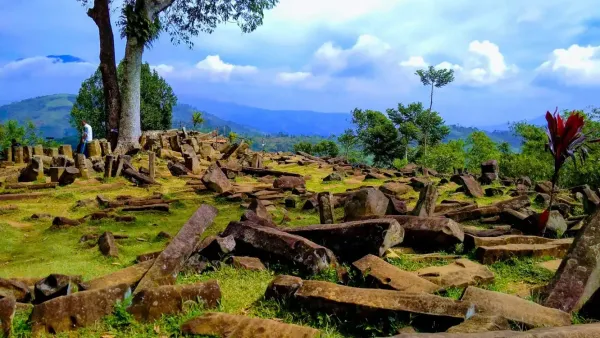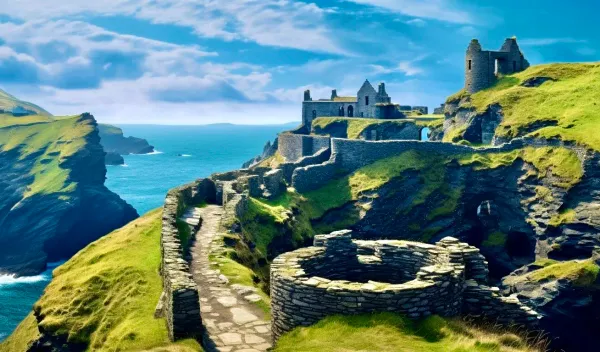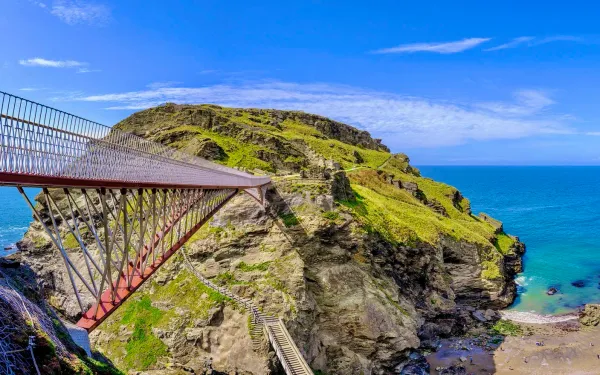Historical Landmarks in the Czech Republic: A Traveler's Delight
Explore the Czech Republic's historical landmarks: majestic castles, ancient bridges, and awe-inspiring cathedrals. Uncover the stories behind each landmark, and immerse yourself in the cultural and architectural marvels that define this enchanting European nation.

Table of Content
Welcome to a journey through the Czech Republic, a gem in the heart of Europe, brimming with stories etched into its cobblestone streets and towering spires. This land, rich in history, unfolds a tapestry woven from centuries of events, rulers, and diverse cultures, creating a narrative that captivates and enthralls. For the traveler with a keen eye for the past, this nation offers a treasure trove of historical landmarks, each with its own tale to tell.
Historical landmarks in the Czech Republic are more than mere relics; they are vivid windows into the nation's history, culture, and traditions. These sites provide a tangible link to the lives and stories of those who shaped the nation, offering continuity and a unique opportunity to walk in the footsteps of bygone generations. As visitors explore these landmarks, they immerse themselves in the narratives that have forged the Czech Republic's identity.
This article aims to be a comprehensive guide for both novice and seasoned travelers eager to explore the Czech Republic's historical wonders. Journey from the vibrant streets of Prague to the charming nooks of the countryside, uncovering the most significant landmarks that mark the chapters of the Czech story. From the imposing Prague Castle to the poignant Terezín, delve into the rich history, cultural significance, and architectural marvels of these destinations in Czechia.
Join us on an enchanting voyage of discovery and wonder through the Czech Republic's historical landmarks. Here, history is not just remembered; it comes vividly to life, integrating the past into a dynamic travel experience. The historical landmarks of the Czech Republic are not just destinations; they are portals to a bygone era, waiting for you to unlock their secrets and revel in their enduring legacy.
Prague: The Heart of Czech History
Before we embark on our journey to explore the historical landmarks of the Czech Republic, we begin our quest in the beating heart of the nation, Prague. As the capital city, Prague is a living testimony to the country's rich and varied history. Its well-preserved historical core, with its cobblestone streets and grandiose architecture, offers travelers a window into the past.
Prague Castle and St. Vitus Cathedral

The historic heart of Prague, the Czech capital, is the legendary Prague Castle (Pražský hrad), an emblem of both political and architectural significance. Dating back to the 9th century, it is not only one of the largest castle complexes in the world but also the official residence of the Czech President. Here, travelers can explore the grandeur of St. Vitus Cathedral (Katedrála svatého Víta), a stunning example of Gothic architecture. This cathedral has witnessed the coronations of Bohemian kings and queens and serves as their final resting place.
The magnificent interior, with its intricate stained glass windows and beautiful chapels, takes visitors on a journey through the history of Bohemia. The castle grounds, including the Royal Palace and Golden Lane, offer a glimpse into the lives of nobles and craftsmen in times gone by.
Charles Bridge

A short walk from Prague Castle, the iconic Charles Bridge (Karlův most) spans the Vltava River, connecting the Lesser Town (Malá Strana) with the Old Town (Staré Město). This historical bridge, adorned with statues of saints, dates back to the 14th century and is not only a vital transportation artery but also a work of art in itself.
As you traverse its cobblestones, you're greeted with captivating views of the city, the castle, and the graceful river. Whether at sunrise, when the bridge is serenely quiet, or during the bustling day and evening, when artists and street performers add to the lively atmosphere, Charles Bridge is a must-visit landmark that encapsulates the spirit of Prague.
Beyond Prague: Exploring Regions
While Prague is a historical gem in its own right, the Czech Republic's historical allure extends far beyond its capital. Beyond the city's borders, the country reveals a tapestry of diverse regions, each bearing its unique historical significance. Let's set off on a journey to explore some of these remarkable destinations:
Kutná Hora

The town of Kutná Hora, located in Central Bohemia, is a testament to the country's fascinating and often dark history. Its most renowned historical landmark is the Sedlec Ossuary, a site that has earned the eerie nickname "Bone Church." Inside this small Gothic chapel, you'll encounter an astonishing display of human bones creatively arranged to form chandeliers, coats of arms, and other decorative elements.
The town's history is deeply tied to its silver mines, which made it one of the wealthiest towns in medieval Europe. As you explore the town's cobblestone streets and visit the Church of St. Barbara, you'll be immersed in the historical ambience of a place that was once a center of great prosperity and culture.
Český Krumlov

Nestled in the picturesque region of South Bohemia, Český Krumlov is a town that seems frozen in time. Its well-preserved medieval old town, a UNESCO World Heritage Site, is a captivating labyrinth of narrow streets, charming squares, and centuries-old architecture.
The crowning jewel of Český Krumlov is its eponymous castle, Český Krumlov Castle, a masterpiece of Renaissance architecture. This monumental structure, surrounded by lush gardens, invites you to explore the life and times of European nobility. As you stroll through the castle's courtyards and admire its stunning frescoes, you'll be transported to a world of opulence and refinement.
Spa Towns and Scenic Beauty
Czech Republic isn't just about history; it's also a place of natural beauty and relaxation. Two of the most noteworthy destinations in this category are:
Karlovy Vary

Karlovy Vary, often known as Carlsbad, is a spa town with a rich history of wellness and rejuvenation. It's famous for its hot springs, which have attracted visitors for centuries. Strolling through the town, you'll encounter ornate colonnades and colorful, elegant buildings, which house the hot spring fountains.
Visitors can partake in traditional spa treatments, sipping from ornate cups, or enjoy the healing properties of the thermal waters. Beyond the spa experience, Karlovy Vary's landscape is nestled in a lush valley, offering hiking opportunities with breathtaking views.
Hluboká Castle

Often referred to as the "Czech Windsor," Hluboká Castle in South Bohemia is a testament to architectural beauty and elegance. Modeled after the grandeur of English castles, Hluboká Castle boasts picturesque spires, turrets, and a surrounding English-style park and gardens. A visit here takes you on a journey through romantic architecture and regal opulence.
The castle's interior is equally captivating, filled with period furniture and exquisite artwork. As you explore the halls and rooms, you'll be transported to a world of aristocratic life and noble splendor.
Tragic History: Terezín and Its Reminders

While the Czech Republic is renowned for its picturesque landscapes and grandiose architecture, it is also a country marked by moments of deep tragedy. Terezín (Theresienstadt) serves as a poignant reminder of one of the darkest chapters in human history.
Terezín's Role during World War II
Terezín, a small fortress town in Northern Bohemia, was transformed into a concentration camp by the Nazis during World War II. It was a place of immense suffering and loss, as countless people, primarily Jews, were interned here under deplorable conditions.
A visit to Terezín is a sobering experience that provides insight into the Holocaust. The former camp has been transformed into a museum that chronicles the lives of those who lived and died here, making it a crucial educational and historical site.
Ghetto Museum and the Small Fortress
The Ghetto Museum within Terezín offers an in-depth exploration of the history of the camp. It showcases the daily lives, cultural activities, and struggles of the inmates. The museum also commemorates the artists, musicians, and intellectuals who tried to maintain a semblance of humanity in the face of unimaginable adversity.
Adjacent to the main camp is the Small Fortress, which served as a prison during World War II. It is a harrowing reminder of the harsh conditions endured by many of the inmates. The Small Fortress is an essential part of Terezín's history and the somber history of the Holocaust.
Visiting Terezín is a solemn but necessary experience, allowing travelers to pay their respects to the victims of the Holocaust and gain a deeper understanding of this tragic period in history.
Historic Beer and More: Pilsen

Leaving behind the somber history of Terezín, our journey takes us to a city that celebrates a different facet of Czech culture - its world-famous beer. Pilsen, or Plzeň in Czech, is a city steeped in brewing traditions and history.
Pilsner Urquell Brewery
Pilsen is the birthplace of Pilsner lager, one of the most popular beer styles worldwide. A visit to the Pilsner Urquell Brewery is a pilgrimage for beer enthusiasts. The brewery, founded in 1842, offers tours that provide insight into the beer-making process and the history of brewing in the region. You can explore the historic cellars, witness the beer production, and, of course, enjoy a fresh pint of Pilsner Urquell.
The brewery's history is intertwined with the city's cultural identity, making Pilsen not only a destination for beer aficionados but also a place where history and culinary delight merge.
Exploring Pilsen's Historical and Cultural Offerings
Beyond beer, Pilsen boasts a rich history and vibrant cultural scene. The Pilsen Historical Underground is a network of tunnels and cellars beneath the city, revealing its medieval origins and history. The city's old town, with its colorful facades and stunning architecture, provides a charming backdrop for exploration.
The Great Synagogue, one of the largest synagogues in the world, reflects Pilsen's diverse heritage. It stands as a symbol of religious tolerance and history, making it a significant historical landmark in the city.
Moravian Charms: Olomouc and Telč
Our journey now takes us to the region of Moravia, which boasts its own unique historical and architectural treasures. Two cities, Olomouc and Telč, offer a distinct perspective on the rich history of the Czech Republic.
Olomouc

Olomouc, the sixth-largest city in the Czech Republic, is known for its well-preserved historical center. The Holy Trinity Column, a UNESCO World Heritage Site, is a remarkable example of Baroque architecture. This towering column, adorned with sculptures and frescoes, stands as a testament to the city's resilience in the face of adversity, particularly during the Thirty Years' War.
The city's Astronomical Clock is another historical marvel. While not as famous as the one in Prague, it is an intricate piece of work with its own unique charm. Olomouc also features historic churches, fountains, and squares that transport visitors to different epochs of history.
Telč

The small town of Telč, also a UNESCO World Heritage Site, is a picturesque gem in South Moravia. Its historical center is a remarkable showcase of Renaissance and Baroque architecture. The beautifully preserved facades of colorful houses that line the town square create an almost fairytale-like atmosphere.
The crowning jewel of Telč is Telč Castle, which sits at the edge of the town square. The castle is known for its stunning interiors and ornate gardens. It's a place where history meets aesthetics in a harmonious blend.
Royal Retreat: Karlštejn Castle

Our exploration through the historical landmarks of the Czech Republic would be incomplete without a visit to one of the most iconic castles in the country: Karlštejn Castle.
Founded by Emperor Charles IV
Located not far from Prague, Karlštejn Castle was founded in the 14th century by Emperor Charles IV, one of the most influential and beloved monarchs in Czech history. The castle was built to serve as a royal treasury and a secure place to safeguard the Czech crown jewels and other precious artifacts.
The architectural style of the castle is a blend of Gothic and Romanesque elements, with its stunning exterior featuring decorative elements and defensive structures. The interior of the castle is equally captivating, with its Great Tower housing the Chapel of the Holy Cross, adorned with remarkable frescoes.
Safeguarding the Czech Crown Jewels
Karlštejn Castle's historical significance is intertwined with its role as the guardian of the Czech crown jewels for several centuries. The Chapel of the Holy Cross, with its intricate decoration and priceless relics, provides a tangible connection to the country's regal past.
Visiting Karlštejn Castle not only offers a glimpse into the life and times of Bohemian royalty but also provides insights into the importance of the Czech monarchy in European history.
Summary
Exploring the Czech Republic's historical landmarks reveals a nation immersed in history, culture, and architectural wonders. Highlights include the grand Prague Castle and Charles Bridge, as well as the poignant Terezín. These sites are not just historical relics; they are vibrant chronicles of the past, where every element narrates the nation's story.
Beyond Prague, destinations like Kutná Hora and Český Krumlov offer unique insights into the nation's history. The spa town of Karlovy Vary and Hluboká Castle showcase the country's diversity and natural beauty. Terezín stands as a somber reminder of the darker chapters of history, honoring those who faced tremendous hardships.
Pilsen presents a different aspect of Czech culture, blending tradition with culinary excellence. The Moravian cities of Olomouc and Telč highlight the diverse heritage, illustrating that the Czech Republic's historical treasures extend beyond a single region.
Karlštejn Castle transports visitors back to the times of kings and emperors, showcasing the country's regal legacy. The Czech Republic's landmarks offer a window into its culture, art, and history, featuring architectural styles from Gothic to Baroque.
This exploration of the Czech Republic's historical landmarks invites travelers to discover these stories and experiences for themselves. Ideal for history buffs, architecture enthusiasts, or curious explorers, these sites connect the past to the present, ensuring the enduring legacy of Czech history.





